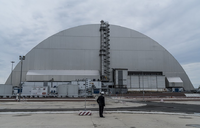Hadopelagic Crater

The Hadopelagic Crater is a massive pit in the Sacovia region of Caplona, in the Principalit of Leucio in Caradia. Originally discovered by Operation Heartland troops, the pit was subsequently put under investigation due to its extremely bizarre circumstances. The immediate inability to ascertain the depth of the pit gave the pit its name.
Upon further investigation using probes and remote sensors, the pit was determined to have a depth of roughly 6,587 metres, meaning it's lowest point reaches the depth of oceanic trenches. The pit seems to also possess an odd property that absorbs all light that enters it once it passes below a certain depth (roughly 300 metres), which prevented attempts to study the pit and ascertain its contents below 300 metres.
The pit is unnaturally devoid of life, including microscopic. Nothing living has been discovered inside the mouth of the pit. This has been attributed to the presence of acidic compound that is found to be secreted from the walls at various points. The source of the acid is as yet unknown.
The Scientific Consortium of Saint Baldur was sent by the Caradian government to investigate the pit. Dignitaries and officials in the organisation ordered the construction of a bunker around the pit in case of an anomalous and unforeseen disaster. After the completion of the containment dome, a military camp was subsequently built around the dome, which was called "Porțile Iadului", commonly referred to by its common tongue translation of "Hellsgate".

A probe was sent into the crater following the completion of the containment dome. The probe lost connection at roughly 300 metres down, and the scientists assumed the probe to be lost. The probe mysteriously reappeared next to the crater the next morning, covered in unknown biological tissue. At approximately noon that day, the crater began issuing gusts of hypothermic (-40 to -60 degrees) air every thirty minutes to two hours. The Ciric Confederacy sent a contingent of researchers to assess the crater and determine its properties following this incident.
Eventually, the tissue that had covered the probe was analysed by biologists and determined to bear remarkable similarities to typical reptilian lung tissue. The lung tissue was determined to not belong to any known organism. Concerned, the confederacy pulled its scientists out of the area. However, the scientists of the Consortium continued in their research of the pit. The scientists proceeded to bring in a bound labourer supplied by the government and drop them into the pit with a microphone connected to a speaker on the surface and a depth meter. The scientists noted that the screams of the labourer devolved from screams of fear to "screams mostly resembling screams made in pain" once they neared the previously established maximum measurable depth. At the same depth as previous experiments' disappearance (316.71 metres), the microphone lost connection and the depth metre detached from the labourer's person.
The next day, a series of surprising things were discovered. First of all, the roof of the containment dome had a large, clean circle hole in it. Directly underneath this hole was an impression of a human body, lying on its back with its arms and legs pressed together. This was next to a series of footprints, described by one scientist as "disturbing, dragging footprints, as if made by someone with little control over their legs". These footprints led to two different scientists' tents (who were confirmed to have disappeared). A thin trail of blood led back from these tents to the pit.